|
|

This tutorial helps you learn how to use Provisioned QoS Policy Manager (QPM-PRO) to create and distribute QoS policies and configurations. It is comprised of a series of lessons, each of which steps you through procedures for creating different types of policies and deploying them to the network.
The tutorial contains the following topics and lessons:
Policy Manager enables you to create and edit QoS policies and configurations. The following topics provide you with the basics for using Policy Manager:
 |
Note When working with QPM-PRO Policy Manager, you can click the Help button in any of the windows to access context-sensitive online help. |
Start Policy Manager to create, change, delete, and view your QoS configuration and policies.
Step 1 Select Start>Programs>QoS Policy Manager Pro>Policy Manager.
If you are not already logged in, QPM-PRO opens the Logon Information window.
Step 2 Log into QPM-PRO. You must enter a QPM-PRO user name and password according to these requirements:
If you enter a correct name and password, Policy Manager starts and automatically opens the last QoS database that was open.
The main Policy Manager window (Figure 3-1) is divided into three panes.
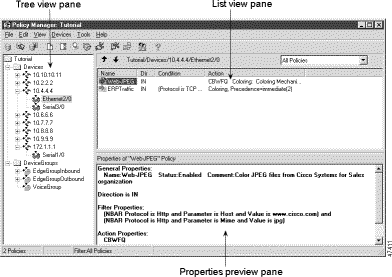
The tree view pane (Figure 3-2) shows the devices and device groups being managed in QPM-PRO. The Devices directory contains a separate folder for each device. Most device folders contain a list of interfaces on which you define QoS policies. For some devices, you define policies directly on the device folder.
The Device Groups directory contains the device groups you have defined. Device groups are groups of interfaces that you intend to manage using identical policies. You must treat all interfaces in a device group identically.

The tree view pane is where you start when creating a policy. If the device is not yet defined in the QoS database, you must first define it and add its interfaces. If the device is already defined in the QoS database, you must select the folder (usually an interface) on which you want to define a policy before you can create (or change) the policy.
| Icon | Description |
|---|---|
| Device |
| Device Group |
| Interface |
| Interface on which the QoS property has been changed or policies have been defined. |
The list view pane (Figure 3-3) shows the policies that are defined on the interface, device, or device group selected in the tree view.
If you select an interface that belongs to a device group, the list of policies includes those defined on the device group, as well as those defined directly on the interface. You cannot edit or change the order of group policies when viewing them from a member interface. Group policies are always given lower priority than individual interface policies.

The top bar of the list view includes the following items:
Each policy in the list is preceded by an icon that indicates the direction of the policy (inbound or outbound) and its status (enabled or disabled). Table 3-2 describes these icons.
| Icon | Description |
|---|---|
| Inbound policy. |
| Outbound policy. |
| Inbound policy on device group. |
| Outbound policy on device group. |
| Disabled policy. |
The properties preview pane displays the properties of the device, device group, interface, or policy selected in the tree or list panes. This can help you determine if you have defined the properties and filter conditions correctly. You can choose not to display the properties preview pane by selecting View>Properties Preview. Repeat this action to redisplay the pane.
You can use the standard Windows cut, copy, and paste functions to manipulate policies in the QPM-PRO list pane.
Step 1 Select the policy you want to cut or copy, or the folder in the tree view in which you want to paste the policy.
Step 2 Use these commands from the Edit menu or from the right mouse button popup menu to cut, copy, or paste.
You can change the main Policy Manager window to display information according to your preferences. Table 3-3 lists the available commands for changing the main Policy Manager window.
| If you want to... | Command | Description |
|---|---|---|
Display or hide the tool bar | View>Tool Bar | The tool bar is the row of short-cut buttons beneath the menu. When Tool Bar is checked on the View menu, the tool bar is displayed. |
Display or hide the status bar | View>Status Bar | The status bar is at the bottom of the window, and displays informative messages as you use Policy Manager. When Status Bar is checked on the View menu, the status bar is displayed. |
Display or hide the properties preview pane | View>Properties Preview | The properties preview is displayed in the lower right pane of the window, and shows the properties of the selected device, interface or policy statement. When Properties Preview is checked on the View menu, the properties preview is displayed. |
You must periodically save your changes to the QoS database. However, saving your changes to the database does not apply those changes to the network. You must use Distribution Manager to deploy your new or changed policies to the network.
Step 1  Click the Save button, or select File>Save.
Click the Save button, or select File>Save.
If the QoS Manager service is not available when you try to save the database, the database is saved to your local disk. Check the machine that is running QoS Manager to ensure it is running properly and try saving the database again.
From the Policy Manager interface, you can close Policy Manager only, or close both Policy Manager and Distribution Manager.
Step 1 To close Policy Manager without closing Distribution Manager, select File>Close.
To close both Policy Manager and Distribution Manager, select File>Exit.
Distribution Manager enables you to deploy policies to network devices. The following topics provide you with the basics for using Distribution Manager:
 |
Note When working with QPM-PRO Distribution Manager, you can click the Help button in any of the windows to access context-sensitive online help. |
Start Distribution Manager to distribute policies and QoS settings to network devices.
Step 1  Click the Distribution Manager button on the Policy Manager tool bar or select Tools>Distribution Manager in Policy Manager.
Click the Distribution Manager button on the Policy Manager tool bar or select Tools>Distribution Manager in Policy Manager.
Distribution Manager starts.
The main Distribution Manager window (Figure 3-4) is divided into three panes.
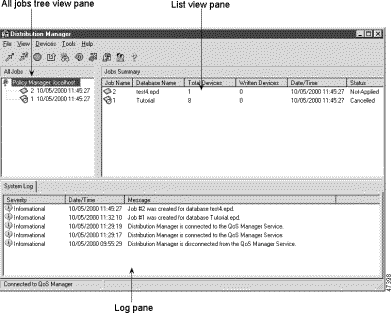
The All Jobs Tree View pane (Figure 3-5) shows all the jobs that you have created from QoS databases. Each job is assigned a number, which is the name of the job.
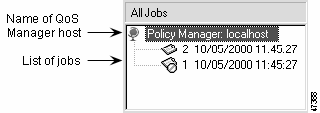
The root of the tree shows the name of the machine that is running the QoS Manager service to which Distribution Manager is connected: localhost means that QoS Manager resides on the same machine as Distribution Manager.
When you select a job in the list, the contents of the job are displayed in the right-hand list view pane. When no job is selected, or when you select the root of the tree, the right-hand list view shows the details for all the jobs listed in the tree.
| Icon | Description |
|---|---|
| QoS Manager host |
| Job |
| Canceled job |
The list view pane shows the contents of the job selected in the All Jobs Tree View (Figure 3-6). If no job is selected in the tree, the list shows the details for all jobs listed in the tree (Figure 3-7).

Job summaries have the following details:

Job contents have the following details:
The log pane (Figure 3-8) displays logs of event messages.
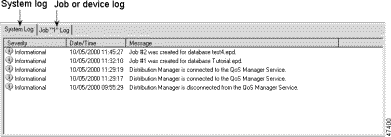
The pane has two tabs to display three types of logs:
You can change the main Distribution Manager window to display information according to your preferences. Table 3-5 lists the available commands for changing the main Distribution Manager window.
| If you want to... | Command | Description |
|---|---|---|
Display or hide the tool bar | View>Toolbar | The tool bar is the row of short-cut buttons beneath the menu. When Toolbar is checked on the View menu, the tool bar is displayed. |
Display or hide the log pane | View>Log | The log pane is the bottom half of the main window, and displays log messages for the system, selected job, or selected device. When Log is checked on the View menu, the log pane is displayed. |
Display or hide the status bar | View>Status Bar | The status bar is at the bottom of the window, and displays informative messages as you use Distribution Manager. When Status Bar is checked on the View menu, the status bar is displayed. |
If Policy Manager is not running, you can start it from Distribution Manager.
Step 1  Click the Policy Manager button, or select Tools>Policy Manager.
Click the Policy Manager button, or select Tools>Policy Manager.
The Policy Manager application starts.
From the Distribution Manager interface, you can close Distribution Manager only, or close both Distribution Manager and Policy Manager.
Check the Status column to make sure that all distribution activities are complete or have been stopped.
Step 1 To close Distribution Manager without closing Policy Manager, select File>Close.
To close both Distribution Manager and Policy Manager, select File>Exit.
This tutorial is based on an example enterprise network that consists of a campus site and several remote sites. Each tutorial lesson applies QPM-PRO techniques and principles to specific segments of this network. In each lesson, a diagram clearly illustrates the relevant network segments, the data path, and the QoS features or policies applied.
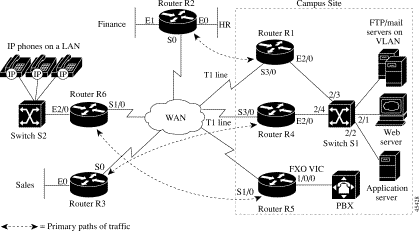
The campus site contains the following components:
This remote site contains a Cisco 2500 router (referred to as router R2), running IOS version 12.0. In the scenario for this tutorial, this router connects the organization's Finance and HR users to the WAN. These users primarily require data from the application server and the FTP/Web server on the campus site. The primary path of data from these servers is from router R1 on the campus site to the remote router R2.
This remote site contains a Cisco2500 router (referred to as router R3), running IOS version 12.0. This router connects the organization's Sales users to the WAN. These users primarily communicate with the application and web servers on the campus site. The primary path of data from these servers to the Sales users is through router R4 on the campus site to the remote router R3.
This remote site contains the following components:
Table 3-6 lists the other technical details of the network that you need to know to follow the lessons. Not all interfaces on the devices are listed.
| Device Name | Device Model and IP Address | Software Version | Interfaces | IP Address | Mask |
|---|---|---|---|---|---|
R1 | 7200 | 12.0 | Ethernet2/0 Standard Ethernet 10,000 Kbit/sec (10 Mb/sec) | 10.1.1.1 | 255.255.0.0 |
Serial3/0 T1 line at 1544 Kbit/second (propPointToPointSerial) | 10.2.2.2 | 255.255.0.0 | |||
R2 | 2500 | 12.0 | Ethernet0 Standard Ethernet 10,000 Kbit/sec (10 Mb/sec) | 10.10.10.1 | 255.255.255.0 |
Ethernet1 Standard Ethernet 10,000 Kbit/sec (10 Mb/sec) | 10.10.11.1 | 255.255.255.0 | |||
Serial0 T1 line at 1544 Kbit/second (propPointToPointSerial) | 10.2.2.3 | 255.255.0.0 | |||
R3 | 2500 | 12.0 | Ethernet0 Standard Ethernet 10,000 Kbit/sec (10 Mb/sec) | 10.10.12.1 | 255.255.255.0 |
Serial0 T1 line at 1544 Kbit/second (propPointToPointSerial) | 10.4.4.5 | 255.255.0.0 | |||
R4 | 7200 | 12.0 | Ethernet2/0 Standard Ethernet 10,000 Kbit/sec (10 Mb/sec) | 10.1.1.2 | 255.255.0.0 |
Serial3/0 T1 line at 1544 Kbit/sec (propPointToPointSerial) | 10.4.4.4 | 255.255.0.0 | |||
R5 | 3600 | 12.1(2)T | Serial1/0 Frame Relay line at 1544 Kbit/sec | 172.1.1.1 | 255.255.0.0 |
R6 | 3600 | 12.1(2)T | Ethernet2/0 Standard Ethernet 10,000 Kbit/sec (10 Mb/sec) | 10.1.1.3 | 255.255.0.0 |
Serial3/0 Frame Relay line at 1544 Kbit/sec | 10.9.9.9 | 255.255.0.0 | |||
S1 | 6509 | 5.5 | VLAN20 propVirtual | 10.10.1.2 | 255.255.0.0 |
S2 | 6509 | 6.1 | VLAN20 propVirtual | 10.10.1.3 | 255.255.0.0 |
Ethernet2/0 Standard Ethernet 10,000 Kbit/sec (10 Mb/sec) | 10.8.8.8 | 255.255.0.0 |
Other interface and device addresses might be used in the lessons.
In this lesson, you will learn how to add a router to the QoS database and create and deploy a simple policy. The policy in this example sets the IP precedence for web traffic that goes through router R4. See Understanding the Tutorial Example Network, for a description of the example network used in this tutorial. The purpose of this policy is to color the web traffic for the Sales group, because the web server behind R4 hosts a significant application used by Sales, and Sales requires good response from this server.
In order to make a meaningful policy, you must not only color the traffic on the inbound interface to the router (interface Ethernet2/0, which connects the web server to R4), but you must choose a QoS property for the outbound interface Serial3/0 (Figure 3-10). You will implement weighted fair queuing (WFQ). This ensures that the colored traffic receives the appropriate percentage of overall bandwidth.

In this lesson you will learn the following:
This topic describes how to add a router to the database. If you are adding a router on your network, you can automatically detect the interfaces and view their properties. You can also manually add interfaces. You will then configure the QoS property on the interfaces to determine which queueing method will be used.
If you want to create a policy and deploy it on a router that exists in your network, obtain the IP address of an appropriate router. Otherwise, you can use the IP addresses in this lesson so that you can follow these steps without affecting your network.
The lesson assumes that you are starting with an empty database.
Step 1 Add router R4 to the QoS database.
a. In the Policy Manager, select Devices>Device>New.
QPM-PRO opens the New Device window.
b. Fill in the New Device window. At minimum, you must supply the following information:
In this example, router R4 is 10.4.4.4, the community string is public, and both passwords are test (Figure 3-11).
c. If your device is offline (for example, if you are using the IP addresses used in this lesson instead of addresses for devices on your network), you must select the device model and the software version in the relevant fields. In this example, router R4 is a Cisco 7200 running IOS software 12.0.
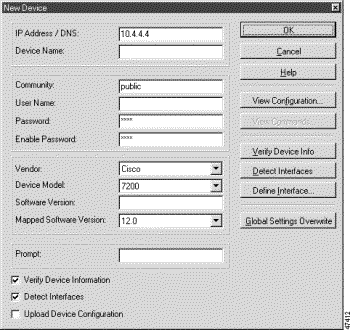
Step 2 Add the device's interfaces:
a. If the device is online:
 |
Note If the software version running on the device is not supported, QPM-PRO maps to the most similar supported version. This feature is described in Lesson 4Updating the Database after Software Upgrades. |
b. If the device is not online, add the interfaces manually:
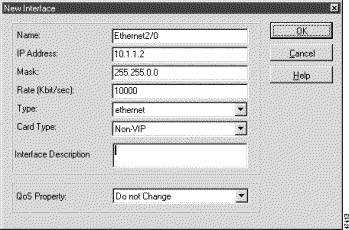
Figure 3-13 shows the tree view that now includes router R4.

Step 3 Configure the QoS property on the Serial3/0 interface so that it uses weighted fair queuing (WFQ). You do not need to change the QoS property of the Ethernet2/0 interface because you are only creating a policy for inbound traffic on Ethernet2/0.
a. Right-click Serial3/0 in the tree view and select Interface Properties.
QPM-PRO opens the Properties of Interface window.
b. Select WFQ in the QoS Property field (Figure 3-14).
c. Click OK.
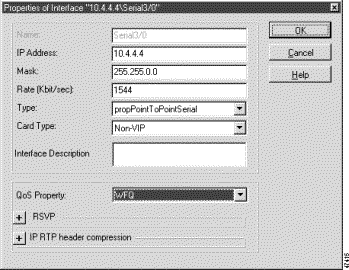
This topic describes how to create a policy to color traffic on an inbound interface. The purpose of this policy is to give high priority to web traffic passing through router R4's Ethernet2/0 inbound interface.
Step 1 Create the policy.
a. Select Router R4's Ethernet2/0 interface in the tree view.
b.  Click the New QoS Policy button, or select File>New>Policy.
Click the New QoS Policy button, or select File>New>Policy.
QPM-PRO opens the Properties of Policy window, in which you will create the policy.
c. In the General Properties page, change the name of the policy and add a meaningful comment. For this policy, use "WebTraffic" and "Color web traffic." Figure 3-15 shows the completed general properties page.
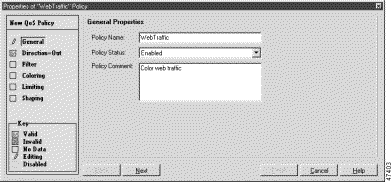
d. Click Next to open the Direction Properties page.
Select the In direction to indicate that the policy is for inbound traffic.
Step 2 Define the policy's filter.
a. Click Next to open the Filter Properties page.
b. In the filters list, select the following values in the same row:
These are the only conditions required to identify web traffic. Figure 3-16 shows the completed Filter Properties window.
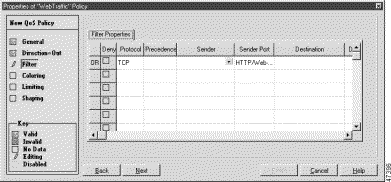
Step 3 Define the policy's coloring action.
a. Click Next to open the Coloring page.
b. Select the Coloring Properties check box. The fields for the coloring properties become active.
c. Select flash-override (4) in the Precedence field to give a higher priority to the traffic that satisfies the policy's filter. Figure 3-17 shows the completed Coloring Properties window.

d. Click Finish to save the policy.
QPM-PRO adds the policy to the Serial3/0 folder.
Step 4  Save your definitions and policies to the database.
Save your definitions and policies to the database.
a. Click the Save button, or select File>Save, to save your policy changes.
Because this is the first time you have saved the database, QPM-PRO opens the Save Database window and you are prompted to name it.
b. For this example, type Tutorial in the Database Name field.
c. Enter a description of the database in the Database Description field, for example, enter Sample tutorial network.
d. Click OK to save the database.
After you have saved your policies in the QoS database, they must be distributed to the network before they will be implemented.
 |
Note If you are working with the examples provided in the tutorial and the device is not in your network, you will not be able to deploy your policies. |
Step 1  In the Policy Manager, click the Distribution Manager button, or select Tools>Distribution Manager, to start Distribution Manager.
In the Policy Manager, click the Distribution Manager button, or select Tools>Distribution Manager, to start Distribution Manager.
Step 2 In Distribution Manager, select Devices>Create Job to create a distribution job from the Tutorial database.
QPM-PRO opens the Create Job window.
Step 3 Select the Tutorial database and click OK.
QPM-PRO creates a distribution job based on the policy definitions in the selected database. The job consists of the commands required to reconfigure the devices to implement your policies. Only the changes made since you last distributed the database are included in the job.
Step 4 Select the job you just created in the tree view.
When you select the job, QPM-PRO displays the contents of the job in the list view. The list view shows the devices whose configurations will be changed by the job. If you double-click the device name in the list view, QPM-PRO displays the commands that will be sent to the device when you apply the job (the device must be available on the network).
Figure 3-18 shows the job selected in the Distribution Manager window.

Step 5  Click the Apply Job button, or select Devices>Apply.
Click the Apply Job button, or select Devices>Apply.
QPM-PRO starts applying the changes defined in the job to the network devices. You can view the job results in the logs displayed in the Log pane at the bottom of the window.
In this lesson, you will learn how to treat a set of device interfaces as a group, and create and deploy a simple coloring policy across the members of that group. The policy in this example will set the IP precedence for Enterprise Resource Planning (ERP) traffic that goes through routers R1 and R4 (see Figure 3-9 for the overall network diagram).
In order to make a meaningful policy, you must not only color the traffic on the incoming interfaces to these routers (the Ethernet2/0 interfaces, which connect the ERP server to R1 and R4), but you must choose a QoS property for the outbound Serial3/0 interfaces (Figure 3-19). You will implement weighted fair queuing (WFQ) on the outbound interfaces. This ensures that the colored traffic receives the appropriate percentage of overall bandwidth.

In this lesson you will learn the following:
If you want to create a policy and deploy it on a device that exists in your network, obtain the IP address of an appropriate device. Otherwise, you can use the IP addresses in this lesson so that you can follow these steps without affecting your network.
This lesson assumes that you have completed the steps in Lesson 1Creating and Distributing a Simple Policy for Managing Web Traffic on One Router.
Device groups allow you to treat selected interfaces or subinterfaces as a single unit, so that you can easily apply common policies or QoS settings to the group.
This topic describes how to add a router (router R1) and create two device groups, one combining the inbound interfaces of routers R1 and R4, and the other combining the outbound interfaces of the routers.
Step 1 Add router R1 to the QoS database.
a. In the Policy Manager, select Devices>Device>New.
QPM-PRO opens the New Device window.
b. Enter information in the New Device window. At minimum, you must supply the following information.
In this example, router R1 is 10.2.2.2, the community string is public, and both passwords are test.
c. If your device is offline (for example, if you are using the IP addresses used in this lesson instead of addresses for devices on your network), you must select the device model and the software version in the relevant fields. In this example, router R1 is a Cisco 7200 running IOS software release 12.0.
Step 2 Add the device's interfaces.
a. If the device is online:
 |
Note If the software version running on the device is not supported, QPM-PRO will map to the most similar supported version. This feature is described in Lesson 4Updating the Database after Software Upgrades. |
b. If the device is not online, add the interfaces manually:
Step 3 Create a device group for the Serial3/0 interfaces on routers R1 and R4, and set the QoS property for the device group to WFQ.
a. Select Devices>Device Group>New, or select the DeviceGroups folder in the tree view, right-click, and select New Device Group.
QPM-PRO opens the Device Group window.
b. In the Device Group window, enter the following information:
c. Click Add/Remove in the Group Members area.
QPM-PRO opens the Add/Remove Group Members window.
d. In the Add/Remove Group Members window, open the trees for each device, select the Serial3/0 interfaces for each device in turn and click >> to add each interface to the group (Figure 3-20).
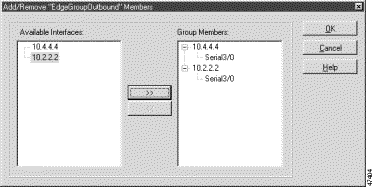
e. Click OK when finished.
Figure 3-21 shows the Device Group window after you have added the Serial3/0 interfaces as group members.
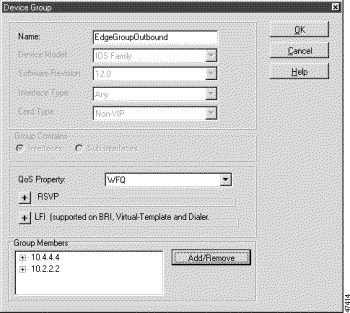
f. Click OK in the Device Group window.
QPM-PRO asks you to confirm that you want the group properties to override the properties already defined on R4's Serial3/0 interface (properties created in Lesson 1Creating and Distributing a Simple Policy for Managing Web Traffic on One Router). Click Yes.
QPM-PRO creates the group and adds it to the DeviceGroups folder in the tree view.
Step 4 Create a device group for the Ethernet2/0 interfaces on routers R1 and R4.
a. Select Devices>Device Group>New, or select the DeviceGroups folder in the tree view, right-click, and select New Device Group.
QPM-PRO opens the Device Group window.
b. In the Device Group window, enter the following information:
c. Click Add/Remove in the Group Members group.
QPM-PRO opens the Add/Remove Group Members window.
d. In the Add/Remove Group Members window, open the trees for each device, select the Ethernet2/0 interfaces for each device in turn and click >> to add each interface to the group.
e. Click OK when finished.
QPM-PRO adds the interfaces to the Group Members list in the Device Group window.
f. Click OK in the Device Group window.
Figure 3-22 shows the tree view with the completed device group entries.
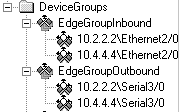
A policy that is created on a device group is applied to all the interfaces belonging to the group. This avoids the need to create individual policies for each interface.
In this lesson, you will create a policy on the EdgeGroupInbound group to color ERP traffic.
Step 1 Create the policy.
a. Select the EdgeGroupInbound group in the tree pane.
b.  Click the New QoS Policy button, or select File>New>Policy.
Click the New QoS Policy button, or select File>New>Policy.
QPM-PRO opens the Properties of Policy window.
c. In the General Properties page, change the name of the policy and add a meaningful comment. For this policy, use "ERPTraffic" and "Color ERP traffic for the HR, Finance, and Sales organizations."
d. Click Next to open the Direction Properties page.
Select the In direction to indicate that the policy is for inbound traffic.
Step 2 Define the policy's filter.
a. Click Next to open the Filter Properties page.
Because the ERP server in this example is dedicated to the ERP applications, as is typically the case, you color all traffic from the server. If other applications were on the same server as the ERP application, you would also use a port filter.
b. Select the following values in the same row:
Step 3 Define the policy's coloring action.
a. Click Next to open the Coloring page.
b. Select the Coloring Properties check box. The fields for the coloring properties become active.
c. Select flash-override (4) in the Precedence field to give a higher priority to the traffic that satisfies the policy's filter.
d. Click Finish to save the policy.
QPM-PRO adds the policy to the EdgeGroupInbound folder.
Step 4  Click the Save button, or select File>Save, to save the policy in the database. Because you used a host name for the ERP server, QPM-PRO asks if you would like the host name resolved to its IP address. Policies can be distributed to the device only if the host names are converted to IP addresses. Click Yes to have QPM-PRO resolve the host name. (Click No if you are following along in this lesson without using actual host names that exist in your network.)
Click the Save button, or select File>Save, to save the policy in the database. Because you used a host name for the ERP server, QPM-PRO asks if you would like the host name resolved to its IP address. Policies can be distributed to the device only if the host names are converted to IP addresses. Click Yes to have QPM-PRO resolve the host name. (Click No if you are following along in this lesson without using actual host names that exist in your network.)
Step 5 Distribute the policy to the network, following the procedure described in Distributing Policies to the Network.
In this lesson, you will learn how to limit the bandwidth that is available to a specific application. The policy in this example will limit FTP traffic passing through switch S1 to a specified bandwidth (see Figure 3-9 for the overall network diagram). FTP traffic that exceeds this bandwidth will be discarded. The purpose of this policy is to prevent FTP traffic from flooding the network and thus reducing the performance of the more important applications on the network.
You will define an application service alias for FTP traffic from the central site, and use the alias to set the limit for FTP traffic to 1024 Kbps (Figure 3-23).
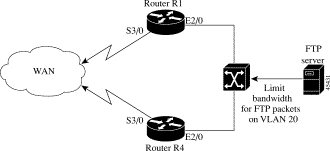
In this lesson you will learn the following:
In order to create and deploy the policy in this lesson, you must have a switch configured with a VLAN in your network. If you have one, use its IP address for the example.
Otherwise, you can use the example IP addresses and values provided in this lesson, so that you can follow the steps without affecting your network.
This lesson assumes that you have completed the steps in the previous lessons.
Since you will be defining a limiting policy on the S1 switch, you first need to add the switch and its interfaces to the database. Switch S1 is a Cat6000 switch running CatOS version 5.5.
In this example, a VLAN has been configured on switch S1. The VLAN includes several of the switch's interfaces. The limiting policy will be defined on this VLAN, therefore, you do not have to define the policy on each interface individually. However, in order to ensure that the policy is applied to all the interfaces that belong to the VLAN, you must add each interface to the database and define the QoS style as VLAN-based (as opposed to port-based).
Step 1 Add the switch S1 and its interfaces to the QoS database.
a. In the Policy Manager, select Devices>Device>New.
QPM-PRO opens the New Device window.
b. Fill in the New Device window. At minimum, you must supply this information.
In this example, switch S1 is 10.6.6.6, the community string is public, and both passwords are test.
c. If your device is offline (for example, if you are using the IP addresses used in this lesson instead of addresses for devices on your network), you must select the device model and the software version in the relevant fields.
Step 2 Add the device's interfaces.
a. If the device is online:
 |
Note If the software version running on the device is not supported, QPM-PRO will map to the most similar supported version. This feature is described in Lesson 4Updating the Database after Software Upgrades. |
 |
Note Make sure that the VLAN and any of its interfaces to which you want the policy to apply, are in the selected interfaces list. |
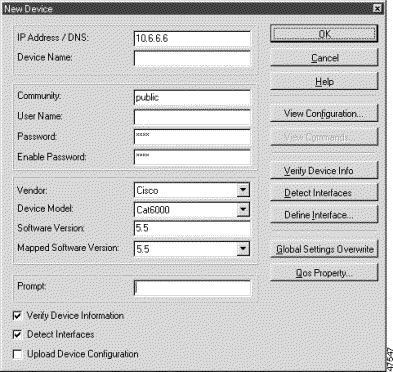
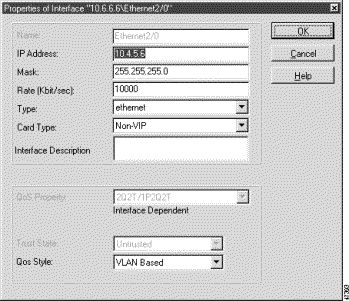
b. If the device is not online, add the interfaces manually:
An application service alias can be defined when you want to identify a particular type of network traffic source from a host or subnet. You can use application service aliases to simplify the writing of your policies, because you can write a policy for the application service instead of one for each host.
In this example, you will create an application service alias for FTP traffic. The filter in your limiting policy will be based on this application alias.
Step 1 Create an application service alias for FTP traffic.
a.  Click the Application Services button, or select Tools>Application Services.
Click the Application Services button, or select Tools>Application Services.
QPM-PRO opens the Application Services window.
b. Click Add in the Application Services window.
QPM-PRO opens the Application Service window.
c. In the Application Service window, fill in the required information to identify the source of the FTP traffic, and to give the application service alias a name.
In this example, you will identify the FTP traffic by using the following attributes (Figure 3-26):
Click OK when finished to return to the Application Services window.
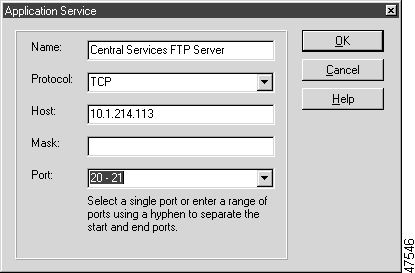
d. Click OK in the Application Services window.
This topic shows how to create a policy on VLAN20 on switch S1 to limit the bandwidth available to FTP traffic.
Step 1 Create the policy.
a. Select VLAN20 in the tree view.
b.  Click the New QoS Policy button, or select File>New>Policy, or right-click in the policy list view and select New QoS Policy.
Click the New QoS Policy button, or select File>New>Policy, or right-click in the policy list view and select New QoS Policy.
QPM-PRO opens the Properties of Policy window.
c. In the General Properties page, change the name of the policy and add a meaningful comment. For this policy, use "FTP Traffic" and "Limit bandwidth for FTP traffic."
d. Click Next to open the Direction Properties page.
e. Select the In direction to indicate that the policy is for inbound traffic.
Step 2 Define the policy's filter. The aim is to identify all FTP traffic coming from the Central Services FTP Server.
a. Click Next to open the Filter Properties page.
b. In the filters list, click in the Sender field and select the type of sender, as follows:
c. Click OK.
Step 3 Define the policy's limiting action, which limits the bandwidth available to the specified application.
a. Click on Limiting on the left side of the Properties of Policy window to open the Limiting Properties page, or click Next until you reach this page.
b. Select the Limiting Properties check box.
The limiting properties fields are enabled.
c. Define the following limiting properties to specify a maximum rate for the traffic and to remove IP precedence from traffic that exceeds this rate:
Figure 3-27 shows the Limiting Properties page after you have defined all the properties.
d. Click Finish to save the policy.

Step 4  Click the Save button, or select File>Save, to save the policy in the database.
Click the Save button, or select File>Save, to save the policy in the database.
QPM-PRO enables you to verify whether the configuration of the devices in your network is different to what was defined for the devices in your QPM-PRO database. You can use this feature to check if any changes have been made to any of your network devices.
After this validation process, you can distribute policies to the network as usual.
Step 1 Create a job in Distribution Manager.
a.  Click the Distribution Manager button, or select Tools>Distribution Manager, to start Distribution Manager.
Click the Distribution Manager button, or select Tools>Distribution Manager, to start Distribution Manager.
b. In Distribution Manager, select Devices>Create Job to create a distribution job from the Tutorial database. QPM-PRO opens the Create Job window.
c. Select the Tutorial database and click OK. QPM-PRO creates a distribution job based on the policy definitions in the selected database. The job consists of the commands required to reconfigure the devices to implement your policies. Only the changes made since you last distributed the database are included in the job.
Step 2 Check the device configuration.
a. Select the job you just created in the tree view.
When you select the job, QPM-PRO displays the contents of the job in the list view, which shows the devices whose configurations will be changed by the job. If you double-click the device name in the list view, QPM-PRO displays the commands that will be sent to the device when you apply the job (the device must be available on the network).
b.  Click the Verify Device Configuration button, or select Devices>Verify Device Configuration.
Click the Verify Device Configuration button, or select Devices>Verify Device Configuration.
QPM-PRO starts checking the configuration of the devices in the job. The result of this validation process appears in the Status column and can be either Matched or Mismatched. Details can be viewed in the log in the lower section of the Distribution Manager window.
Step 3 Apply the job.
a.  Click the Apply button, or select Devices>Apply. QPM-PRO starts applying the changes defined in the job to the network devices. You can view the results of the jobs in the logs displayed in the bottom pane of Distribution Manager.
Click the Apply button, or select Devices>Apply. QPM-PRO starts applying the changes defined in the job to the network devices. You can view the results of the jobs in the logs displayed in the bottom pane of Distribution Manager.
In this lesson, you will learn how to update the QoS database to recognize that you have upgraded the software on a device.
QPM-PRO uses the device IOS version number to load device capabilities to the database. All sub-versions of a certain version are mapped to the major version, unless QPM-PRO explicitly supports the minor version. New minor versions are mapped to the last supported minor version. For example, version 12.1(5)T would be mapped to version 12.1(2)T. QPM-PRO provides you with the option of manually changing the mapped version number if you require the QoS features of a different version.
In most cases, your QoS configuration and policies remain unchanged after a software upgrade. However, in certain cases, QPM-PRO changes the implementation of policies to take advantage of the features of a new software release (without changing the meaning of your policies). Table 3-7 explains the changes that are made for some software upgrades.
| IOS Software Upgrade | Policy Conversion |
|---|---|
11.1cc to 11.2 or 11.3 | Converts coloring policies from CAR to policy based routing (PBR). |
11.2 or 11.3 to 12.0 | Converts coloring policies from PBR to CAR. |
12.0 to 12.0(5)T on a 2500 router | Converts coloring policies from PBR to CAR. |
Upgrading the device software does not affect any device groups to which the device's interfaces belong. You must recreate the device groups if you want them to be restricted to the updated software version.
In this lesson, you will learn the following:
This lesson assumes that you have completed the steps in the previous lessons.
For the purpose of this lesson, assume that you have upgraded the IOS software version on routers R1 and R4 from version 12.0 to version 12.1(2)E.
Step 1 Start QPM-PRO and open the Tutorial database.
Step 2 Change the device properties for router R1:
a. Select router R2 (10.2.2.2) and select Devices>Device>Properties.
QPM-PRO opens the Device Properties window.
b. Click the Verify Device Info button.
QPM-PRO queries the router and updates the software version number and device model, and makes policy conversions if required.
(If you are not using a real device, instead of clicking Verify Device Info, select 12.1(2)E in the Mapped Software Version field.)
 |
Note The detected software version is displayed in the Software Version field. If this version is not supported, QPM-PRO maps to the most recent, most similar supported version, which is displayed in the Mapped Software Version field. You can manually select a different software version in this field if you require its specific capabilities. |
c. Click OK to save the changes to the device configuration. QPM-PRO informs you if there are any conflicts between the QoS configuration and policies defined on the device's interfaces and the new software version. You must resolve the conflicts before you can complete the changes to the device properties.
Step 3 Use the same procedure to change the software version for router R4 (10.4.4.4) to 12.1(2)E.
At this point, you have updated the software versions on the devices. However, this change has not affected the definitions of the EdgeGroupInbound and EdgeGroupOutbound device groups, even though these device groups contain only members from the R1 and R4 routers. To take advantage of IOS software version 12.1(2)E QoS features, you must recreate these device groups as IOS software version 12.1(2)E device groups.
To avoid having to recreate the existing policies in the device groups, you can copy them over to a new device group, then delete the old device group, and then rename the new device group.
Step 1 Create a new device group with software version 12.1(2)E:
a. Select Devices>Device Group>New to create a new device group.
QPM-PRO opens the Device Group window.
b. Enter a temporary name for the device group (egi) in the Name field, and select 12.1(2)E in the Software Version field (Figure 3-28).
c. Click OK when finished.
QPM-PRO creates the egi device group.
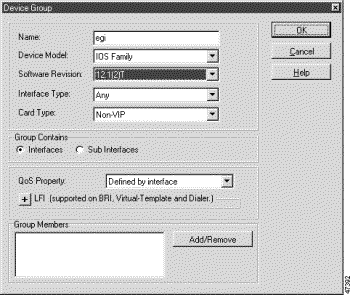
Step 2 Copy the ERPTraffic policy from the EdgeGroupInbound device group to the new device group:
a. Select the EdgeGroupInbound device group in the tree view pane.
b. Right-click on the ERPTraffic policy in the list pane and select Copy. This copies the policy to the Windows clipboard.
c. Select the egi device group in the tree view pane.
d. Right-click in the list pane, and select Paste. This pastes a copy of the ERPTraffic policy to the device group.
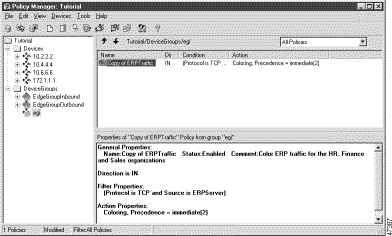
e. Double-click the Copy of ERPTraffic policy in the list pane.
QPM-PRO opens the policy in the Properties of Policy dialog.
f. Change the name of the policy from "Copy of ERPTraffic" to "ERPTraffic" and click Finish.
QPM-PRO changes the name of the policy.
Step 3 Remove the devices from the EdgeGroupInbound device group and delete the device group.
a. Select the EdgeGroupInbound device group and select Devices>Device Group>Add/Remove Members.
QPM-PRO opens the Add/Remove Members window.
b. Expand the tree for each group member and note which interfaces belong to the group.
c. Select each group member and click << to remove it from the group.
d. Click OK when finished.
Because there are policies defined on the group, QPM-PRO asks if you want the policies copied to the interfaces you are removing from the group. Click No All, because when you are finished, these policies will again be defined for the interfaces on a device group.
QPM-PRO removes the members from the group. EdgeGroupInbound should now have no members.
e. Select the EdgeGroupInbound device group and select Devices>Device Group>Delete.
QPM-PRO asks you to confirm that you want to delete the device group and the policies it contains. Click Yes. QPM-PRO deletes the device group.
Step 4 Add devices to the new egi device group and rename the device group.
a. Select the egi device group and select Devices>Device Group>Add/Remove Members.
QPM-PRO opens the Add/Remove Members window.
b. Select the interfaces you removed from EdgeGroupInbound (10.2.2.2\Ethernet2/0 and 10.4.4.4\Ethernet2/0) and click >> to add them to the group.
c. Click OK when finished.
QPM-PRO adds the members to the group. The egi group should now have the same membership as the original EdgeGroupInbound device group.
d. Select the egi device group and select Devices>Device Group>Properties.
QPM-PRO opens the Device Group window.
e. Change the name of the egi group to EdgeGroupInbound and click OK.
Step 5 Change the EdgeGroupOutbound device group to an IOS software version 12.1(2)E device group. Since there are no policies defined on this device group, you only need to remove the members from the device group, change the software version and then add the members back into the device group.
a. Select the EdgeGroupOutbound device group in the tree view pane and select Devices>Device Group>Add/Remove Members.
QPM-PRO opens the Add/Remove Members window.
b. Expand the tree for each group member and note which interfaces belong to the group.
c. Select each group member and click << to remove it from the group.
d. Click OK when finished.
QPM-PRO informs you that it will change the QoS property for member interfaces to WFQ (because that is the QoS property defined for the group).
e. Click Yes.
f. Right-click on the EdgeGroupOutbound device group in the tree view pane and select Device Group Properties.
QPM-PRO opens the Device Group window.
g. Select 12.1(2)E in the Software Version field and click OK.
h. Select Devices>Device Groups>Add\Remove Members.
QPM-PRO opens the Add/Remove Members window.
i. Add the interfaces you removed from the device group (the Serial3/0 interfaces of routers R1 and R4) back into the group, by selecting each one and clicking >> to add it to the group.
j. Click OK when finished.
QPM-PRO informs you that the QoS property defined for the group will override the one defined on the interface, and asks you to confirm that you want to add the interface to the group.
k. Click Yes.
QPM-PRO adds the members to the group.
Step 6  Click the Save button, or select File>Save, to save your changes.
Click the Save button, or select File>Save, to save your changes.
Step 7 Distribute your policy to the network, following the procedure described in Distributing Policies to the Network.
In this lesson you will learn how to create a multiple-action policy to police and color specific traffic generated from a network-based application, using Network Based Application Recognition (NBAR) to identify the application. Refer to Using Network Based Application Recognition (NBAR) with CBWFQ.
The policy will apply the following actions to MIME type web traffic, specifically JPEG files, passing from a specific host through router R4 and out to the WAN (see Figure 3-9 for the overall network diagram):
QPM-PRO uses modular CLI to implement this policy. Modular CLI separates traffic into classes and defines properties for each class.
 |
Note The policy in this lesson can be created only if your IOS software version supports modular CLI and NBAR. |
In order to enable the options that will allow you to define the example policy, you will choose Class Based QoS in the QoS Property field for the outbound (Serial3/0) interface on router R4.
In this lesson you will learn the following:
This lesson assumes that you have completed the steps in the previous lessons.
If you are using actual devices in your network, make sure that the IOS version is 12.1(2)E or above.
If you want to create a policy and deploy it on a device that exists in your network, obtain the IP address of an appropriate device. Otherwise, you can use the IP addresses in this lesson so that you can follow these steps without affecting your network.
The first step in this lesson is to define the QoS property on Serial3/0 on router R4 as Class Based QoS. This will enable you to use NBAR properties as a filter during policy definition.
Before you can do this, you need to remove the outbound interface (Serial3/0 on router R4 from the device group to which it belongs (EdgeGroupOutbound), so that you can change its QoS property.
Step 1 Remove R4's S3/0 interface from the EdgeGroupOutbound device group.
a. Select the EdgeGroupOutbound device group in the tree view.
b. Select Devices>Device Group>Add/Remove Members or right-click on the EdgeGroupOutbound device group in the tree view and select Add/Remove Members.
QPM-PRO opens the Add/Remove Members window.
c. In the Add/Remove Members window, in the Group Members list, select router R4 (10.4.4.4) and click << to remove the device from the group (Figure 3-30). Click OK when finished.
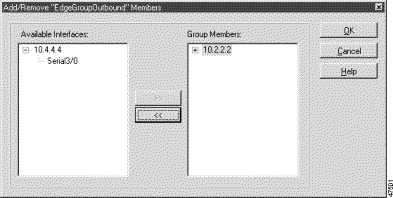
d. QPM warns you that the removed Serial3/0 interface will retain the QoS property defined for the group (WFQ) and requests confirmation of the removal. Click Yes.
The EdgeGroupOutbound device group now contains one device only (R1).
Step 2 Change the QoS property on the outbound interface (Serial3/0 on router R4) to Class Based QoS.
a. In the tree view, open the tree for router R4 (10.4.4.4).
b. Right click Serial3/0 and select Interface Properties.
QPM-PRO opens the Properties of Interface window.
c. Select Class Based QoS in the QoS Property field.
d. Click OK.
QPM-PRO provides the capability to create multiple-action policies, if the IOS software version running on your device supports modular CLI. For this example, you will create a policy on the outbound interface (Serial3/0 on router R4) that performs three actions on the traffic that matches the filter (web traffic of MIME type from www.cisco.com):
Step 1 Create the policy.
a. Select router R4's Serial3/0 interface in the tree view.
b.  Click the New QoS Policy button, or select File>New>Policy or right-click in the policy list view and select New QoS Policy.
Click the New QoS Policy button, or select File>New>Policy or right-click in the policy list view and select New QoS Policy.
QPM-PRO opens the Properties of Policy window, in which you will create the policy.
c. In the General Properties page, change the name of the policy and add a meaningful comment. For this policy, use "Multiple Action" and "Manage critical web traffic."
d. Click Next to open the Direction Properties page.
Select the Out direction to indicate that the policy is for outbound traffic.
Step 2 Define the policy's filter.
a. Click Next to open the Filter Properties page.
b. Click the NBAR Properties tab, since the traffic identification for this policy is via NBAR (Figure 3-31).

c. Click Add.
d. The NBAR Properties window is displayed.
e. Supply the following information in the NBAR properties window to identify web traffic originating from the Cisco Systems host (Figure 3-32):
Click OK.

f. Click Add and add a second row of NBAR properties, as follows:
Click OK.
The NBAR Properties tab now shows the two filters you defined (Figure 3-33). By default, the Match ALL NBAR rows AND ANY filter row radio button is selected, therefore, packets must match both filters in order for the defined action to be carried out.

Step 3 Define the policy's queuing action, which ensures that the specified traffic receives a minimum percentage of the total bandwidth during times of congestion.
a. Click Next to open the Queuing Properties page.
b. Select the Queuing Properties check box.
The queuing properties fields are enabled.
c. Type 20 in the Bandwidth field to ensure that the specified traffic receives a minimum of 20% of the total bandwidth when the line is congested (Figure 3-34).
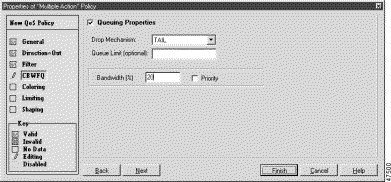
Step 4 Define the policy's coloring action, which provides the specified traffic with high IP precedence.
a. Click Next to open the Coloring Properties page.
b. Select the Coloring Properties check box. The fields for the coloring properties become active.
c. Select flash-override(4) in the Precedence field to give high priority to the traffic that matches the defined NBAR properties.
Step 5 Define the policy's limiting action, which lowers the priority of the traffic if it exceeds a specific rate. This ensures that the specified traffic does not use more than its defined minimum bandwidth.
a. Click Next to open the Limiting Properties page.
b. Select the Limiting Properties check box.
The limiting properties fields are enabled.
c. Define the following limiting properties:
Figure 3-35 shows the Limiting Properties page after you have defined all the properties.
d. Click Finish to save the policy.
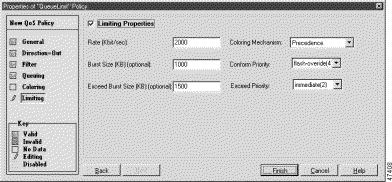
Step 6  Click the Save button, or select File>Save, to save the policy in the database.
Click the Save button, or select File>Save, to save the policy in the database.
Step 7 Distribute your policy to the network, as described in Distributing Policies to the Network.
In this lesson, you will learn how to enable QoS features on router interfaces and create policies that will provide the highest priority for delay and jitter sensitive, real-time Voice over IP (VoIP) traffic.
To achieve this, you will define the following QoS features on the router interfaces:
In addition, you will create a policy that specifies that VoIP traffic be placed in a priority queue for priority treatment with a minimum bandwidth allocation. The following queuing mechanism is used:
The VoIP scenario includes the following components (Figure 3-36):
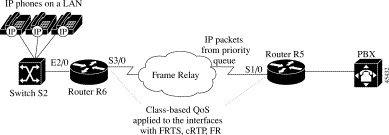
In this lesson you will learn the following:
If you want to create a policy and deploy it on a device that exists in your network, obtain the IP address of an appropriate device. Otherwise, you can use the IP addresses in this lesson so that you can follow these steps without affecting your network.
This lesson assumes that you have completed the steps in the previous lessons.
The first step in this lesson is to add routers R5 and R6 and their interfaces, and switch S2 and its interfaces, to the database.
Step 1 Add router R5 to the database.
a. In the Policy Manager, select Devices>Device>New or right-click in the tree view and select New Device.
QPM-PRO opens the New Device window.
b. Fill in the New Device window. At minimum, you must supply this information.
In this example, router R5 is 172.1.1.1, the community string is public, and both passwords are test (Figure 3-11).
Step 2 Add the device's interfaces.
a. If the device is online:
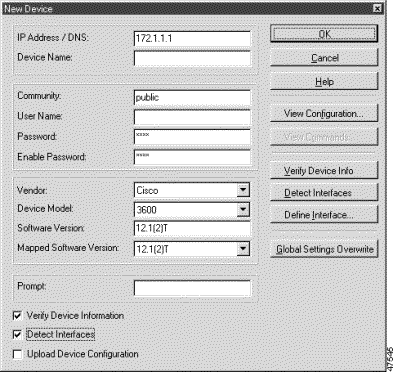
b. If the device is not online (for example, if you are using the IP addresses used in this lesson instead of addresses for devices on your network):
Figure 3-38 shows the tree view that now includes router R5.
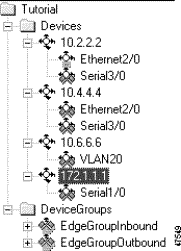
Add router R6 and its E2/0 and S1/0 interfaces to the database, following the procedures in Steps 1 and 2 above.
Step 3 Add switch S2 to the database. If you are working offline, the example switch S2 has an IP address of 10.8.8.8, the community string is public, and both passwords are test.
Step 4 Add switch S2's interfaces to the database. See Adding a Switch and Its Interfaces to the Database, for procedures.
 |
Note QPM-PRO supports both port-based and VLAN-based QoS. When working with VLANs, you must make sure that the physical interfaces on the VLAN to which you want your QoS definitions to apply, have VLAN-based QoS style defined. You can do this by accessing the properties of each interface and specifying VLAN Based in the QoS Style field. |
Since VoIP signals from both the campus site and the remote site require high priority and QoS, you will create a device group that includes the outbound interfaces of the edge router on both sides (routers R5 and R6). You will then define QoS features and policies on the device group. This precludes having to repeat the same procedure on each router individually.
You will define the QoS property, Class Based QoS, on the device group. This QoS property includes CBWFQ and enables you to define other QoS features on the device group for managing voice (and any other real-time traffic), including FRTS, cRTP and bandwidth for voice configuration.
Step 1 Create the Device Group.
a. Select Devices>Device Group>New or right-click in the tree view pane and select New Device Group.
QPM-PRO opens the Device Group window.
b. In the Device Group window, enter the following information:
Notice that when you select Class Based QoS, additional options are provided at the bottom of the window (Figure 3-39).

c. Click Add/Remove in the Group Members area.
QPM-PRO opens the Add/Remove Group Members window.
d. In the Add/Remove Group Members window, select the serial interfaces for each device in turn and click >> to add each interface to the group.
Step 2 Define Frame Relay Traffic Shaping (FRTS) parameters (Figure 3-40).
a. Click the plus sign (+) next to Frame-Relay Traffic Shaping to display the fields for FRTS.
b. Select the Enable Frame-Relay Traffic Shaping check box.
c. Enter values for the FRTS parameters. For the example, enter the following values (in kilobits per second):
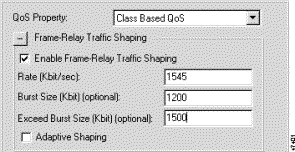
Step 3 Enable IP RTP header compression to help reduce delay for VoIP traffic.
a. Click the plus sign (+) next to IP RTP Header Compression.
b. Select the Enable IP RTP Header Compression check box.
Step 4 Configure the bandwidth and fragmentation for Voice over Frame Relay (Figure 3-41).
a. Click the plus sign (+) next to Voice Configuration.
b. Select the Enable Voice Configuration check box.
c. Enter 50 in the Bandwidth field. This means that 50% of the total bandwidth on the interface will be reserved for VoIP traffic.
d. Enter 40 in the Fragment field. This means that when fragmenting data frames, the size of each fragment will be 40 Bytes.
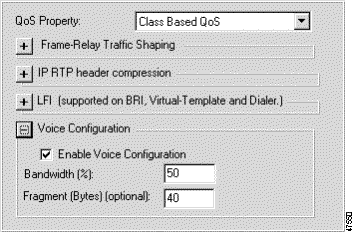
This topic describes how to create a policy that specifies a range of RTP ports whose traffic is guaranteed strict priority service over any other queues or classes using the same outbound interface. You will create the policy on the VoiceGroup device group you just created, so that it will be applied to the outbound interfaces of both R5 and R6.
Step 1 Create the policy.
a. Select the VoiceGroup device group in the tree view pane.
b.  Click the New Policy button, or select File>New>Policy, or right-click in the policy list view and select New QoS Policy.
Click the New Policy button, or select File>New>Policy, or right-click in the policy list view and select New QoS Policy.
QPM-PRO opens the Properties of Policy window, in which you will create the policy.
c. In the General Properties page, change the name of the policy and add a meaningful comment. For this policy, use "VoicePriority" and "Define priority bandwidth allocation and coloring for voice traffic."
d. Click Next to open the Direction Properties page.
e. Select the Out direction to indicate that the policy is for outbound traffic.
Step 2 Define the policy's filter. Since VoIP traffic uses RTP ports, you will specify a range of ports as your filter.
a. Click Next to open the Filter Properties page.
b. Click on the IP RTP tab.
c. Select the Enable IP RTP check box.
d. Specify a port range of 16834 to 32767, which is the RTP port range (Figure 3-42).
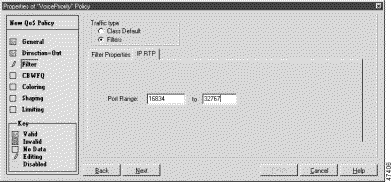
Step 3 Define the policy's queuing action, which creates a priority queue for the VoIP traffic, ensuring that it will be transmitted before any other queued traffic and that it will be given a minimum bandwidth allocation.
a. Click Next to open the Queuing Properties page.
b. Select the Queuing Properties check box.
The queuing properties fields are enabled.
c. Select the Priority check box.
d. Type 50 in the Bandwidth field to ensure that the VoIP traffic in the priority queue receives a minimum of 50% of the total bandwidth.VoIP traffic is guaranteed this bandwidth under worst-case congestion scenarios. If excess bandwidth is available, the priority class will be allowed to utilize the bandwidth. If no excess bandwidth is available, the priority traffic will be constrained to the configured rate via packet drops.
Step 4 Define the policy's coloring action, which gives high IP precedence to the VoIP traffic.
a. Click Next to open the Coloring Properties page.
b. Select the Coloring Properties check box.
The coloring properties fields are enabled.
c. Select Precedence in the Coloring Mechanism field and Critical(5) in the Precedence field.
d. Click Finish to save the policy.
Step 5  Click the Save button, or select File>Save, to save the policy in the database.
Click the Save button, or select File>Save, to save the policy in the database.
Step 6 Distribute your policy to the network, following the procedure described in Distributing Policies to the Network.
This topic describes how to specify that the strict priority queue provided by 1P2Q2T queuing on switch S2's VLAN, is reserved for traffic with IP Precedence 5. The next step will be to color VoIP traffic with IP Precedence 5 so that it will be placed in this priority queue.
Step 1 Right-click on Switch S2 (10.8.8.8) in the tree view pane and select Device Properties.
QPM-PRO opens the Device Properties window.
Step 2 Click QoS Property.
QPM-PRO opens the Properties of CatOS Queuing window, with the 1P2Q2T tab displayed. The window contains a table in which you can map a specific IP precedence to a queue.
Step 3 In the table, select Critical (5) for Queue 3, which is the priority queue (Figure 3-43).
Step 4 Click OK.

Step 5 Click OK in the Device Properties window.
This topic describes how to create a policy on Switch S2's inbound VLAN20 to color VoIP traffic from the IP phones with high IP precedence.
Step 1 Create the policy.
a. Select Switch S2's VLAN20 interface in the tree view.
b.  Click the New QoS Policy button, or select File>New>Policy.
Click the New QoS Policy button, or select File>New>Policy.
QPM-PRO opens the Properties of Policy window, in which you will create the policy.
c. In the General Properties page, change the name of the policy and add a meaningful comment. For this policy, use "VoiceTraffic" and "Color voice traffic."
d. Click Next to open the Direction Properties page.
Select the In direction to indicate that the policy is for inbound traffic.
Step 2 Define the policy's filter.
a. Click Next to open the Filter Properties page.
b. In the filters list, specify the following values in the same row:
c. Click OK.

Step 3 Define the policy's coloring action.
a. Click Next to open the Coloring page.
b. Select the Coloring Properties check box. The fields for the coloring properties become active.
c. Select critical (5) in the Precedence field to give a highest priority to the traffic that satisfies the policy's filter.
d. Click Finish to save the policy.
Step 4  Save your definitions and policies to the database.
Save your definitions and policies to the database.
a. Click the Save button, or select File>Save, to save your policy changes.
In this lesson, you will learn how to configure Frame Relay traffic shaping (FRTS) on Cisco routers. FRTS is frequently used to throttle traffic to the rate agreed upon with your WAN service provider, particularly if the destination link is running at a lower bandwidth than the source link.
For example, you might have a T1 line running at 1544 Kbps, but your service provider is committing to provide only 512 Kbps, and the destination of your traffic is a link running lower bandwidth than 1544 Kbps. By throttling the traffic rate at the source, you ensure that the traffic does not overwhelm the WAN link, resulting in dropped packets and increased delay. With FRTS, you can control the rate and smooth the traffic flow.
This example uses a different network setup than used in previous lessons. Figure 3-45 shows three routers connected over a Frame Relay cloud. All links are T1 Frame Relay lines. The Main router uses subinterfaces to enable routing between the two remote offices, Remote1 and Remote2. Most WAN traffic originates from the main office, so you will implement FRTS on the subinterfaces on the Main router. The service provider has committed to 512 Kbps for the Main-Remote1 link, and 256 Kbps for the Main-Remote2 link. There is no rate commitment for the interfaces on the remote links.

In this lesson, you will learn the following:
If you want to create a policy and deploy it on a device that exists in your network, obtain the IP address of an appropriate device. Otherwise, you can use the IP addresses in this lesson so that you can follow these steps without affecting your network.
This lesson assumes that you have completed the steps in Lesson 6Providing QoS for Voice Over IP. Although you will not use the same network setup, you should already be familiar with adding devices and interfaces to the QoS database.
Step 1 Add the Main router to the database, using 10.10.10.11 for the device name. See Lesson 1Creating and Distributing a Simple Policy for Managing Web Traffic on One Router, for the steps for adding devices to the databases, if you are not familiar with the procedure.
Table 3-8 lists the device details for this example. Because Remote1 and Remote2 links do not have a committed information rate, you are not enabling FRTS or other QoS capabilities on these routers in this example. Therefore, you only need to add Main, its Serial3/0 interface, and its subinterfaces to the database.
| Name | Device Model | Software Version | Interfaces | IP Address | Mask |
|---|---|---|---|---|---|
Main | 7200 | 12.1 | Serial3/0 T1 line at 1544 Kbit/second (Frame Relay) |
|
|
Serial3/0.1 Used as a permanent virtual circuit (PVC) with the Remote1 router, data link connection identifier (DLCI) 150. | 10.10.10.11 | 255.255.255.0 | |||
Serial3/0.2 Used as a PVC with the Remote2 router, DLCI 151. | 10.10.11.11 | 255.255.255.0 | |||
Remote1 | 4500 | 12.1 | Serial0 T1 line at 1544 Kbit/second (Frame Relay) | 10.10.10.10 | 255.255.255.0 |
Remote2 | 4500 | 12.1 | Serial0 T1 line at 1544 Kbit/second (Frame Relay) | 10.10.11.10 | 255.255.255.0 |
Step 2 Enable FRTS on the Main router's Serial3/0 interface. You must enable FRTS on an interface in order to configure FRTS on the interface's subinterfaces:
a. Right-click Serial3/0 in the 10.10.10.11 folder and select Interface Properties.
QPM-PRO opens the Properties of Interface window.
b. Select FIFO as the QoS Property. You must select a QoS Property other than "Do Not Change" if you want to configure interface QoS capabilities such as FRTS.
c. Select Enable Frame Relay Traffic Shaping.
d. Enter 512 in the Rate field.
e. Select Adaptive Shaping. This allows the interface to respond to notifications of congestion from the Remote1 and Remote2 routers, and throttle traffic accordingly.
Figure 3-46 shows the completed interface properties.
f. Click OK when finished.
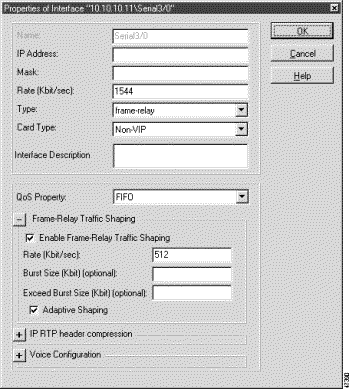
Step 3 Enable FRTS on the Main router's Serial3/0.1 interface:
a. Right-click Serial3/0.1 in the 10.10.10.11 folder and select Interface Properties.
b. Make the following selections:
Figure 3-47 shows the completed interface properties. Click OK when finished.

Step 4 Use the same procedure to enable FRTS on the Serial3/0.2 interface, making the following interface selections:
Step 5  Click the Save button, or select File>Save, to save your changes.
Click the Save button, or select File>Save, to save your changes.
Step 6 Distribute your settings to the network, as described in Distributing Policies to the Network.
![]()
![]()
![]()
![]()
![]()
![]()
![]()
![]()
Posted: Fri Aug 16 09:52:30 PDT 2002
All contents are Copyright © 1992--2002 Cisco Systems, Inc. All rights reserved.
Important Notices and Privacy Statement.